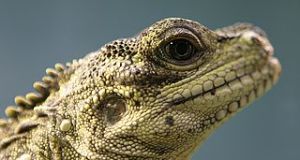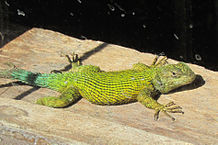 Bent-toed geckos (Genus Cyrtodactylus, i.e. C. louisiadensis and C. irianjayaensis) are becoming ever more popular in captivity but, while a fascinating group, their care is often fraught with difficulties, and there is a great deal of conflicting information being circulated. A recent note from blog reader Dave, upon whom I can always count for interesting comments and questions, brought these wonderful creatures to mind again.
Bent-toed geckos (Genus Cyrtodactylus, i.e. C. louisiadensis and C. irianjayaensis) are becoming ever more popular in captivity but, while a fascinating group, their care is often fraught with difficulties, and there is a great deal of conflicting information being circulated. A recent note from blog reader Dave, upon whom I can always count for interesting comments and questions, brought these wonderful creatures to mind again.
Dave noted the scarcity of husbandry information regarding bent-toed geckos, and mentioned that his lizard, purchased as a giant bent-toed gecko, was not feeding with very much vigor. Following are some exerts from my response to Dave, along with a few additional notes.
The Genus Cyrtodactylus
So far, 115 species have been described in the genus Cyrtodactylus. The giant bent-toed gecko is often sold as the “New Guinea phase” of C. louisiadensis, but is actually a separate species, C. irianjayaensis. To further confuse matters, stores sometimes mix up the various species, and coin their own names.
There are still many questions as regards the husbandry and natural history of the giant bent-toed gecko. Over the years, I’ve had a number of little known species of the same genus (Cyrtodactylus) pass through my hands, and have found the following general principles to be of use.
The Importance of a Secure Environment
Give the animal as much space as possible, with lots of cover and places to climb…suspended pieces of rolled cork bark make perfect shelters. Bent-toed geckos are very stress-prone, but don’t always exhibit the behavioral signs of stress – flight, panting, threat displays – so commonly seen in other lizards; disturb it as little as possible. These are definitely animals to observe, not handle. A night-viewing bulb will allow you to watch the lizard as it goes about its nocturnal wanderings without undue disturbance.
Providing Security
One useful technique that works with animals of all types is to provide a solid wall or two. You may notice that well-run zoos rarely exhibit animals in cages having all sides are open to view.
In an aquarium, you can cover some of the glass with dark paper or cardboard. Even where shelters are available, this simple step often makes a great difference in the animal’s welfare, and brings about immediate changes in its behavior.
Next time I’ll cover lighting and feeding, including a note on the use of snails in the diet of this and related geckos.
Further Reading
A listing of all species with the genus Cyrtodactylus, along with range information, may be found at
http://www.jcvi.org/reptiles/search.php?submit=Search&exact%5B%5D=genus&genus=Cyrtodactylus
The image pictured above was referenced from Wikipidia and features a related species; not the Giant Bent Toed Gecko. Originally posted by W.A. Djatmiko.
 That Reptile Blog – Reptile, Amphibian and Exotic Pet Care and Information
That Reptile Blog – Reptile, Amphibian and Exotic Pet Care and Information




Hi Frank,
Great article can’t wait to read the next part. Thanks for all the useful information.
-Dave
Hello Dave, Frank Indiviglio here.
Thanks for your kind words …your comments spurred the article, much appreciated as always.
Best regards, Frank Indiviglio.
Frank,
Can we expect a second part to this article? Would be great. Thanks!
-Dave
Hello Dave, Frank Indiviglio here. Thanks for your kind words.
There is a good deal more to cover regarding these lizards; I have some feelers out for new information and hope to cover additional topics/species in the future.
Thanks as always for your interest and support.
Best regards, Frank Indiviglio.
what do they eat.
Hello,
They should be fed a wide variety of invertebrates..please see this article for further information. They have high calcium requirements,…small snails are the best source of calcium, but all food should also be powdered with supplements (see article); adults can be offered a pink mouse each 6 weeks or so as well. best,. Frank